
Bob the cat made his home in the Grand Union Tea Company building from about 1900 to 1903. The large factory and headquarters complex at 58-68 Jay Street was bounded by Jay, Pearl, Front, and Water Streets, on what was once the waterfront property of Comfort and Joshua Sands.
In the 1904 edition of King’s Views of Brooklyn, the Grand Union Tea Company building in Brooklyn’s present-day DUMBO neighborhood was listed as the “largest warehouse and factory in the United States for teas, coffees, spices, flavoring extracts, baking-powders and soaps.” By the mid-1920s, the Grand Union warehouse had 10 acres of floor space. In addition to a yearly output of 32 million pounds of coffee and 4 million pounds of tea, the warehouse shipped 120,000 cakes of soap, 50,000 cans, 180,000 cartons, and 20,000 pounds of baking soda each day.
It was in this immense building that a black-and-white cat named Bob made his home for three short years.
According to building chief engineer Calvin and Superintendent Lent, Bob was brought to the building around 1900 when he was still a very young kitten whose eyes had just opened. He belonged to no one in particular, but he thrived on “promiscuous charity.”
As Bob grew older, he began to develop predatory instincts. He had full run of the enormous building, which became his hunting ground. Bob started out catching giant water bugs and cockroaches, but within months he was a Grade A mouser. Although he could go wherever he pleased, Bob spent a lot of time on top of the giant boiler in the building’s basement, especially when it was cold outside.
One wintry day in 1903 Bob disappeared. When he didn’t show for his rounds as usual, the men began to wonder where he had gone. A search party was organized, but the cat was never found. Over the next few months, he was sadly forgotten.
Poor Bob is Found in the Boiler

Headline from the New York Times, June 20, 1903
On June 20, 1903, laborers were removing a disused boiler in the basement of the Grand Union Tea Company building when they made a sad and gruesome discovery inside the boiler’s safety valve. According to reports, the position of the cat was so lifelike that one of the workmen who was removing the boiler jumped back in fright and nearly fell from his step ladder.
According to chief engineer Calvin, Bob appeared to be emerging from the safety valve at the top of boiler and preparing to spring. When the worker saw that the angry-looking cat did not attack, he gained courage and got closer to investigate. He called out softly, “Kitty, kitty, kitty.”
As the Brooklyn Daily Eagle reported, “Kitty did not respond, but retained the attitude of rigid and uncompromising hostility.” Bob’s fur had retained all its color and his eyes glistened in the half-light, but when the man touched the cat he found the body to be hard as stone.
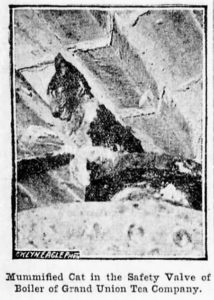
This image of the mummified cat appeared in the Brooklyn Daily Eagle on June 20, 1903. It’s hard to see, but you can just make out a white paw wrapped around the black safety valve, as well as the side of Bob’s upper body and face.
When Calvin heard of the mummified cat, he went up the ladder and looked at the remains. “That’s Bob, as sure as I’m an engineer,” he said. “Poor old Bob!”
Calvin surmised that it must have been a very cold night, and Bob must have crawled into the safety valve and fallen asleep. The escaping gas was what probably killed him.
Perhaps, Calvin suggested, he woke up and had just enough strength to try to get out of the valve. The heat of the boiler was not enough to cook him or burn his fur — it simply dried him out into nothing but fur-covered bone.
“He’s as good a mummy as you could find in Egypt.”
A Brief History of the Grand Union Tea Company
This concludes the sad tale of Bob the mummified cat. The following history should hopefully take your mind off the poor kitty and his gruesome fate.
In 1872, Frank Jones came up with an idea to sell tea and coffee directly to customers, rather than going through the middleman grocer. He and his brothers, Cyrus and Charles, established the Grand Union Tea Company and the Jones Brothers Company, and began selling tea and coffee door to door in Scranton, Pennsylvania.
In 1896, Frank and Cyrus Jones began buying property on the block bounded by Jay, Front, Pearl, and Water Streets in Brooklyn (Charles had retired in 1893). Construction on the new Grand Union Tea Company plant and headquarters building took place place over almost 20 years, from 1896 to 1915.
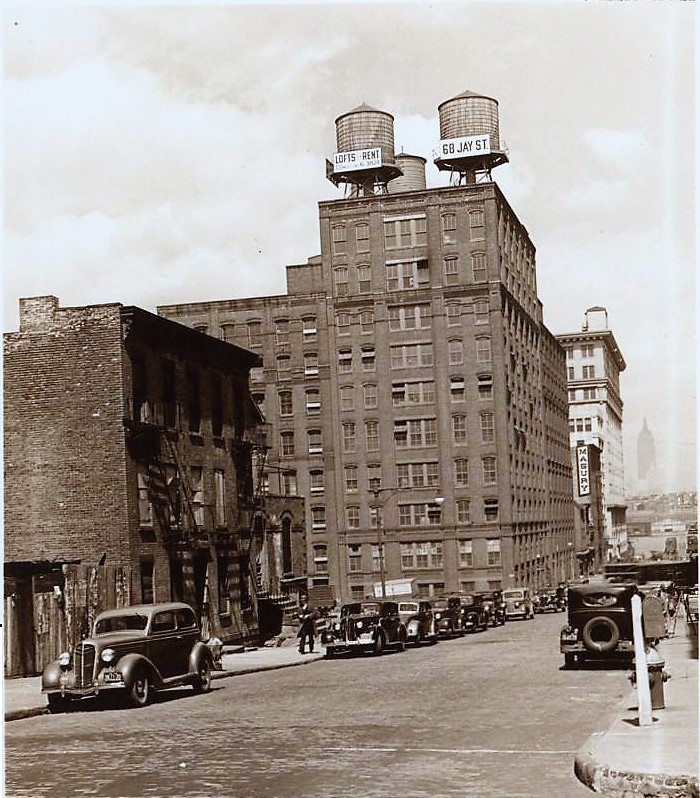
The old Grand Union Tea Company building at 58-68 Jay Street in 1938, eight years after the Jones family sold the property.
Over the years, the Jones brothers developed one of the largest grocery store chains in America. In 1916, all of the firms owned by the Jones brothers, including the Jones Brothers Company, Grand Union Tea Company, Anchor Pottery Company, and Globe Grocery Stores merged and formed the Jones Brothers Tea Company. By 1917, the combined company operated 262 stores in 33 states and Washington, D.C.
In 1928, the Jones family sold the chain to a banking syndicate headed by Brown Brothers and Company. The company relocated out of state, but the Jones’ heirs retained the land in Brooklyn until they sold it in 1930. Over the years, the building has housed many manufacturers, including Advance Battery Company, Triangle Steel Products, and Automatic Range Company. Today it continues to house businesses, offices, and artist showrooms.
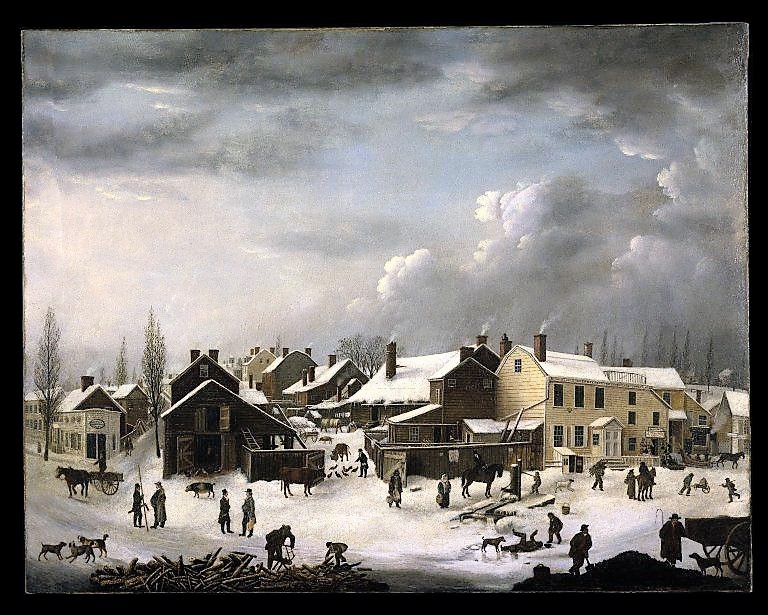
This Francis Guy illustration looks like a Currier & Ives Christmas card, but it’s actually Brooklyn’s Front Street in 1820, just 75 years before the Jones brothers started constructing their Grand Union Tea Company. Brooklyn Museum
The Property of Comfort and Joshua Sands
The block on which the old Grand Union Tea Company building was constructed was once a small section of the large tract of land owned by Comfort and Joshua Sands. In fact, all of the streets in the area were named by the Sands brothers in the 1780s: Pearl and Front Streets were named after streets of the same name in Manhattan, Jay street was named in honor of Governor John Jay, and Water street was named because the street ran along the high water mark of the East River in some sections.
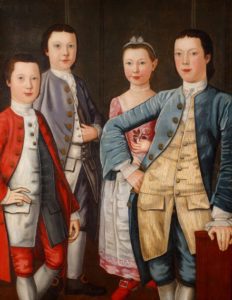
The Rapalje Children, by John Durand (1768). New-York Historical Society
The earliest recorded history of the area goes back to 1637, which is the year the Canarsee Tribe sold a large tract of land extending along the East River from the old Fulton Ferry Landing to today’s Brooklyn Navy Yard (what are now the historic districts of DUMBO and Vinegar Hill).
The man who purchased the land was a Dutch settler named Joris Jansen Rapalje (or Rapalye).
The Rapaljes were Tories who remained loyal to the British Crown during the Revolutionary War. In accordance with New York State’s 1779 “Act for the Forfeiture and Sale of the Estates of Persons who Have Adhered to the Enemies of this State,” the family’s lands were confiscated on October 27, 1779. The Rapaljes were banished and eventually returned to England in 1783.
On July 13, 1784, Comfort and Joshua Sands purchased 160 acres of Rapalje’s confiscated land bordering the East River for 12,450 pounds, paid to the Commissioners of Forfeiture.
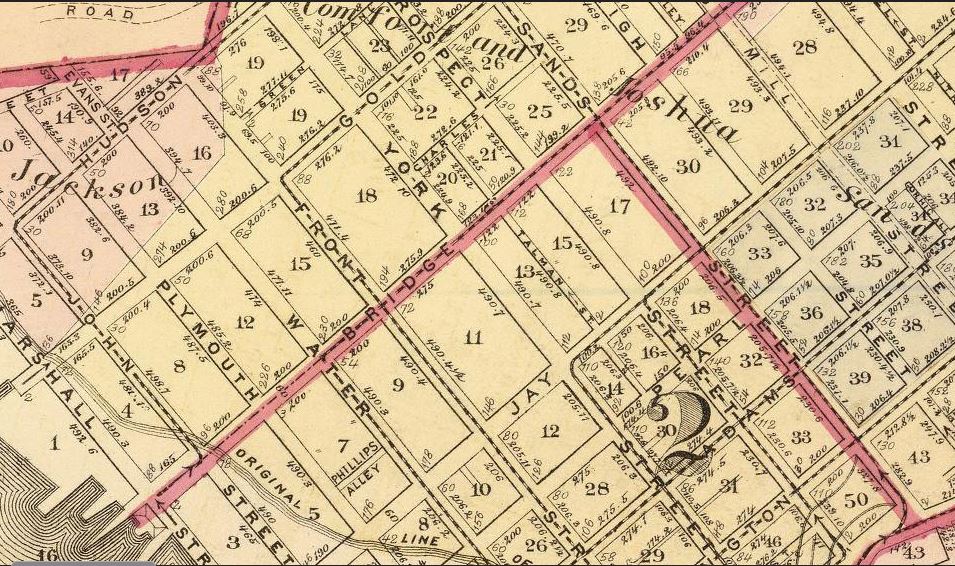
The old Sands tract is noted in yellow on this 1874 Brooklyn map. The block numbered “10” at bottom center is where the Grand Union Tea Company building was erected from 1896 to 1915. Note the original water mark line just under Water and Plymouth Streets.
The Sands family traces its American roots to James Sands, an Englishman who arrived at Plymouth, Massachusetts in 1658 (hence, Brooklyn’s Plymouth Street). James Sands and several other men obtained what is now Block Island, Rhode Island, from the Narragansetts in 1660. His son John later purchased farmland in Cow Neck, Long Island, which is today called Sands Point.
Comfort Sands was born in Cow Neck on February 26, 1748. He opened a store on Peck Slip in Manhattan in 1769 and supported the patriots’ cause during the Revolutionary War. In 1783, he and his younger brother, Joshua, established a mercantile business involved in foreign trade and land speculation. The following year the Sands became a household name in Brooklyn when they purchased the Rapalje land.
Comfort had 18 children, 15 of whom were born to his first wife Sarah Dodge, and three born to his second wife, Cornelia Lott. He was a founder and director of the Bank of New York and served as president of the New York Chamber of Commerce from 1794 to 1798. He died in Hoboken, New Jersey, in 1834.
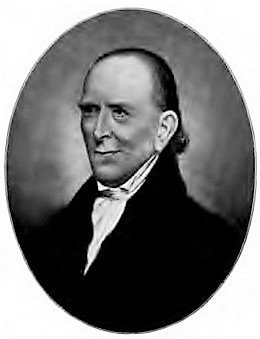
Joshua Sands served as a United States congressman from 1803 to 1805 and again from 1825 to 1827. He died in 1835.
Joshua Sands, born in Cow Neck on October 12, 1757, served as a captain in the American army during the Revolutionary War. Following the purchase of the Rapalje property in 1784, he built a three-story Federal style mansion at 31 Front Street. At the time of its completion, the house was the largest mansion in Brooklyn. He and his wife, Ann Ayscough, had 12 children.
The Village of Olympia
In 1788, Joshua, Comfort, and shipbuilder John Jackson (who was the Sands’ neighbor to the east) began to develop a new planned community called Olympia on the waterfront portion of the Sands’ new property. The brothers envisioned Olympia to become a summer retreat for New Yorkers, who would flock there for its hilly topography, plentiful water, and refreshing breezes.
The following excerpt from The History of Kings County, Including Brooklyn (1884) describes the virtues of the location:
“Olympia is extremely well calculated for a city; on a point of land which presents its front up the East River, surrounded almost with water, the conveniences are almost manifest. A considerable country in the rear affords the easy attainment of produce. A pure and salubrious atmosphere, excellent spring water, and good society, are among a host of other desirable advantages. As regards health in particular, it is situated on the natural soil — no noxious vapors, generated by exhalations from dock-logs, water and filth sunk a century under its foundations are raised here.”
Although the land was surveyed by C. T. Goerck and streets were laid out, Olympia was never completed. The Sands brothers did establish a rope-making facility along the waterfront, and a few houses and other structures went up here and there, but development was limited until after the Brooklyn Navy Yard and Jackson’s toll road were opened in the early the nineteenth century.
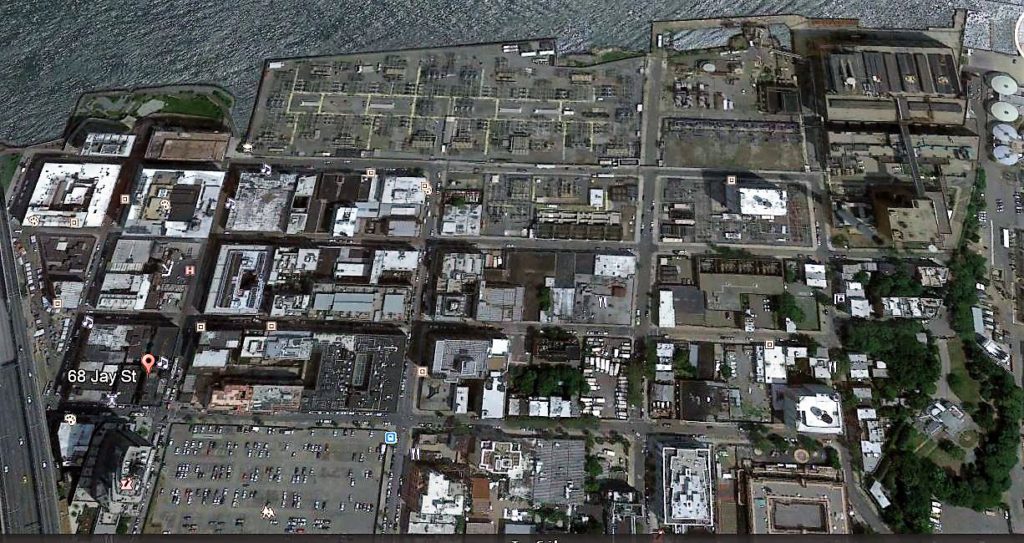
Here’s an aerial view of what was once the property of Comfort and Joshua Sands. The old Grand Union Tea Company building at 68 Jay Street is at the bottom left. Google Earth




Had a Grand Union store w/i walking distance when I was a kid, no superstores back then.